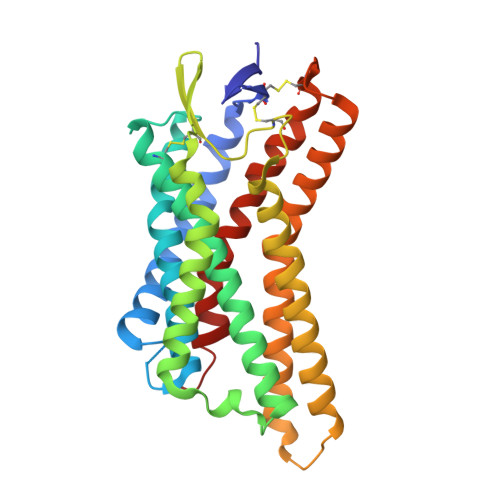Structure-guided design of a peripherally restricted chemogenetic system.
Kang, H.J., Krumm, B.E., Tassou, A., Geron, M., DiBerto, J.F., Kapolka, N.J., Gumpper, R.H., Sakamoto, K., Dewran Kocak, D., Olsen, R.H.J., Huang, X.P., Zhang, S., Huang, K.L., Zaidi, S.A., Nguyen, M.T., Jo, M.J., Katritch, V., Fay, J.F., Scherrer, G., Roth, B.L.(2024) Cell 187: 7433-7449.e20
- PubMed: 39631393
- DOI: https://doi.org/10.1016/j.cell.2024.11.001
- Primary Citation of Related Structures:
8UTD, 8UUJ, 9CIB - PubMed Abstract:
Designer receptors exclusively activated by designer drugs (DREADDs) are chemogenetic tools for remotely controlling cellular signaling, neural activity, behavior, and physiology. Using a structure-guided approach, we provide a peripherally restricted Gi-DREADD, hydroxycarboxylic acid receptor DREADD (HCAD), whose native receptor is minimally expressed in the brain, and a chemical actuator that does not cross the blood-brain barrier (BBB). This was accomplished by combined mutagenesis, analoging via an ultra-large make-on-demand library, structural determination of the designed DREADD receptor via cryoelectron microscopy (cryo-EM), and validation of HCAD function. Expression and activation of HCAD in dorsal root ganglion (DRG) neurons inhibit action potential (AP) firing and reduce both acute and tissue-injury-induced inflammatory pain. The HCAD chemogenetic system expands the possibilities for studying numerous peripheral systems with little adverse effects on the central nervous system (CNS). The structure-guided approach used to generate HCAD also has the potential to accelerate the development of emerging chemogenetic tools for basic and translational sciences.
- Department of Biotechnology, College of Life Science and Biotechnology, Yonsei University, Seoul, South Korea.
Organizational Affiliation:

















